
—— SPECIFIC FASHIONS OF THE 1880’s——
It was the Cult of Beauty, with Tailor Made High Fashion. The high fashion style of the era was severely tight with restrictive corsetry worn under dresses with long boned bodices, tight sleeves, and high necks most notable.
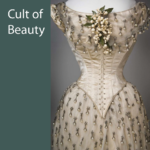
- On the surface a very modest & even prudish look, this line was so torso defining that a woman’s shape could hardly go unnoticed, indirectly creating the most revealing & sensuous look yet in history
- Ensembles of this era were (& are) very expensive to make because of the amount of fabric, detail, structure, & expertise required
- The counter “Aesthetic” & “Mass Produced” movements were popular because they cost so much less & were so much easier to make than this mainstream fashion “Tailor Made” style
- By 1883 both day & evening clothes had become flamboyant, due to heavy decoration with drapes & frills
- Notable at this time were military dresses & “mannish” shirts with high collars the same as men were wearing at the time
- The line of the clothes was considered most important
- The Princess sheath garments had no waist seam. The bodice & skirt were cut as one, & the bodice line was similar to the very tight fitting cuirasse
- The cuirasse bodice was long & slim fitting in 1876 & by 1878 it reached the thighs
- The 1878 cuirasse was corset like & dipped deep in both front & back, giving the look of a body encased in armor
- By 1880 the ideas of the princess line merged with the cuirasse line to become the “Princess Panel Dress”. The result was a slim & elongated silhouette that was even further elongated by a train
- No bustle was used, although a pad was sometimes placed to help the fabric fall & drape correctly
- It took a very skilled dressmaker to get a flattering fit. Too often swathes of fabric were wrapped & arranged across the garment to hid poor sewing skills
- It was only suited to the very slim & women who did not have to work, so the fashion only lasted about 3 years
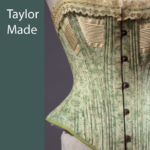 CORSETS
CORSETS
- Women were still very corseted & wired, with shapes specifically altering the body
- These corsets demanded expert tailoring construction as they defined the hourglass to the very end of the 1890’s
- The long corset put tailors back in business, although there was such a wide variety available on the mass market, custom made was not necessary, but desired as an option
- Corsets were very much mass produced & marketed largely through catalogs & department stores
- There were many styles of corsets for all activities, price points, & manufacture
- The most successful corset manufacturer was located in the United States
- Corsets of this era were still called “cuirass bodices” since they held the woman in a kind of body armor, not unlike ancient warriors. (The name “cuirass” is from the name “cuirbouli” or “boiled leather”, the process used by ancient Greeks & Romans to produce their rigid, thick leather fighting body armors)
- The long look was created by having each individual piece shaped for the long body contour desired for the purpose or individual
- Corsets of the 1890’s to 1901 were made of one single layer of coutil fabric
- Corsets of this era continued to get longer, & were very tightly laced from 1880-1890
- They had little separation of breasts, & created a low, full bust
- The spoon busk was nearly always used except in sports corsets. They widened out & then curved inwards towards the bottom in a spoon shape
- Spoon busks were used to hold the abdomen flat, & not create a bump in the smooth line of the front of the skirt. This became more important at the turn of the century, when the “tulip” flared skirt would become the vogue
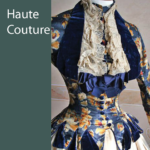 BODICES & JACKETS
BODICES & JACKETS
- From about 1882 the plain high-necked & tight-fitting day bodice grew shorter
- Bodices were severe & austere
- The pointed bodice was very tailored, similar to 1874, but was more of a suit now
- Bodices were cut to a point at the center front until 1885 when it was pointed in the center back also
- The bodice was by 1889 cut below the waistline
- Only the bodice or jacket was tailored now. The skirt remained elaborately draped to emphasize the tiny corseted waist
- For day wear most bodices had some type of center front interest
- Imitation blouse & revers were popular
- A rever was an insert sewn inside the bodice to appear to be a full blouse, similar to the visual effect of the chemisette (which was separated from the main garment as an accessory)
- Long, jacket-like fitted bodices called basques were popular for day wear
- Evening bodices were very plain & fitted; looking more like decorated corsets with small puff sleeves or decorated straps
- The decolletage on ball gowns was cut slightly wider & to a point at both front & back
 SLEEVES & COLLARS
SLEEVES & COLLARS
- Sleeves were the distinguishing characteristic of this era
- Sleeves started the era as the same 2-piece of the early 1870’s, having heavy cuff decoration, & getting slightly narrower by 1880
- Sleeves were plain & tight from 1880 to 1882
- From about 1882 onward a little fullness was being cut into the head of the sleeve
- Sleeves suddenly ballooned to proportions never seen before after 1883, reaching their peak of large size in 1895-96
- A set of Balloon sleeves on one garment could require up to 21 yards of 22″ wide fabric
- Women had to turn sideways to fit through doors to avoid crushing their sleeves
- Leg O’Muttom, Melon, Gigot, & Balloon were a few names given to the different shapes
- The head of the sleeve was often covered over by frills or a flounce or revers coming across from the bodice
- Sleeves were set into a high or normal armhole with the width at shoulder level rather than swelling from the low dropped armhole of the 1830’s when sleeves were almost this large
- Evening dresses of the mid 1880’s often had a lace flounce added above the sleeve to increase the impression of width
- Evening gowns sometimes had elbow length sleeves in the 1885-86 period
- By 1886 the sleeve gathers were lifted by a full pad to hold the size. They were stuffed with taffeta, paper, batting, & anything light enough with volume to hold them out
- As time progressed towards 1887, sleeves quickly became slimmer again & more plain & close fitting
- Evening & ball gowns were usually sleeveless & low necked throughout the era except for matrons who wore a higher neck
- Most necks were finished with a standing collar called an “officer collar” based on men’s military fashion of the day
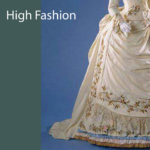 SKIRTS & TRAINS
SKIRTS & TRAINS
- As the 1880’s progressed, as in the previous era, emphasis remained on the back of the skirt, with fullness gradually rising from behind the knees to just below the waist
- Hips became more prominent in focus in 1881 & 1882, hinting at the larger bustle to come in 1883
- 1884 saw the simplification of ideas & plainer clothes
- The dress itself had minimal drapery throughout the era. Fabric drapery was neatly arranged in front of the dress like a small apron, but it was still very heavy with large amounts of fabric because the huge bustle required a very wide skirt
- Also like the previous era, focus was still on the skirt with its pleats, flounces, draped panier, or apron effects
- Due to so much draped & heavy fabric, dresses of this era could weigh 15 – 20 pounds, not including understructures
- Skirts were almost always layered & draped, often with an apron front & a trained back
- Pleating was everywhere, both in skirt construction & in trimming.
- There continued kilting, braiding, & other trim throughout, though not as much in combination or excess as the prior era
- Gowns typically did not have a long train in the back, which was different from gowns of the 1870’s
- Skirts were known as “hobble skirts” due to the tightness of them which made it difficult to walk, thus evolving the use of small pleats & flounces at the bottom so the feet could move
- While trains were no longer worn for day, they persisted for evening wear
- Trains were often a separate attachment which could be fastened under or draped at the back of the skirt
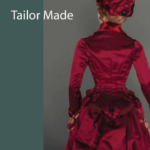 OVERSKIRTS & APRONS
OVERSKIRTS & APRONS
- The apron front was still popular from the 1870’s period, & was worn both centered or asymmetrically
- The apron was usually cut with a square-shaped corner at the bottom
- There was a virtually endless variety of method of draping & pleating & frills
- As the era progressed, hems came up, & clothing was designed to make the faster paced life more efficient & comfortable
- In 1886 skirts were more subdued, the drapes were less tortured
- The fabrics of several underskirts were pleated from the waist to fall to the hem in large flat pleats
- The overskirt was then draped up in the back over the bustle into large swags & waterfalls
- In 1889 pleats were 4-5″ deep & they were stiffened & grouped round the end of the point of the back bodice
- By 1889, the stiff pleats lifted above the bottom of the bodice at the back, as if in defiance of the demise of the bustle
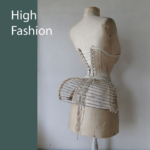 THE BUSTLE RETURNS – #3 – 2nd BUSTLE ERA
THE BUSTLE RETURNS – #3 – 2nd BUSTLE ERA
- The 1881-1883 period, situated between the two bustle eras, was known for being without bustle
- The fullness over the bottom in the absence of a bustle from 1881-1883, was balanced by a fuller, lower chest, achieved by rigid corseting creating an S-shaped silhouette
- The return of the bustle was marketed in Paris in 1880
- Brought back by popular demand in 1883, it was not embraced outside of France completely until 1885
- The return was gradual, & it is sometimes difficult to determine examples of the 1880’s since they crossed over the eras to include everything from no bustle to the 1st bustle “fishtails” to the huge 2nd era bustle all at one time
- All the bustles were worn to some extent through the period until the bustle abruptly disappeared completely in 1890
- The 1883 bustle returned changed from what it had been
- It was now worn at a lower placement with a narrower width
- This was a remake of the 1793 bustle, but in huge proportion
- Very different from the 1870’s bustle also, the 1885 version jutted out horizontally from the hollow of the back
- The bustle was very structured & the effect was accomplished with dress & ornament as well as understructure
- Dresses worn over this new frame were sturdier, being constructed in heavier fabrics such as velvet, satin, or wool
- This 2nd bustle was a “hard bustle” which could stand on its own rigidly horizontal
- It was larger than ever as a hard shape & looked like the hind legs of a horse
- A metal spring pivot type of bustle gave strong support for the larger & heavier skirts
- Its supporting structure became much more rigid & was made of metal bands which worked on a pivot
- The Lillie Langtry invented bustle model of this era could be raised when sitting, & spring back automatically when a lady stood up
- The large bustle reached its most aggressive form in 1886
- The late era 1884-86 bustle was very molded to the body
- Combined with heavier corsetry, the fashion gave an overall appearance of wearing armor due to its rigidity
- By 1888 the bustle was in decline, & by 1889 only a pad was used
- By 1890, it was abandoned all together
 UNDERGARMENTS
UNDERGARMENTS
- Drawers & chemises were combined in 1877 & called “combinations
- A combination was a camisole with attached knee or calf length drawers
- Combinations were worn under the corset, bustle, & petticoat
- Woolen combinations were recommended at the time for health, especially when engaging in fashionable sports
- They were sometimes high-necked & long-sleeved for day wear
- Daywear combinations were made of linen, merino, calico, or nainsook
- The petticoat was made to stay as flat as possible along the front to maintain the smooth line of the bodice
- Petticoats in this era were strictly inside garments under the skirt
- They were designed to follow the shape of the skirt
- Many had ruffles or flounces of self-fabric along the hemline and/or from waist to knee to hold the skirt away from the legs
- Because of the combination, there was not so much need for use of the petticoat for warmth or modesty as previously
- Some women did not wear petticoats of the dress fabric combined with the bustle was stiff enough to stand without one
- In the late 1880’s & 1890’s, the petticoat was more like a 2nd or 3rd skirt & less of an undergarment
- The design & manufacture of a late era petticoat matched that of the skirt as closely as possible, & might even be of a complimentary fabric to be seen as one of the outer layers of the dress
- By 1890 the chemise, drawers, & ruffled petticoats would be replaced by combinations entirely, because they reduced bulk around the waist where women were aiming for a completely smooth line from chest to knee
- Petticoats would later be called a “slip”; a long cotton or silk garment to keep the outer garment from chafing without causing bulk or bump to the silhouette
- They would eventually have one long line from neck to hem the same as the dress
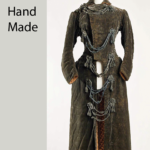 OUTERWEAR
OUTERWEAR
- Outwear evolved from the need for more active wear
- Riding habits had become a “uniform” of matching jacket & skirt worn with a high-collared shirt or chemisette, with top hat & veil
- Riding habits were worn without bustles, but the cut of the jacket still followed the silhouette of the day
- In contrast, hunting costumes adhered to current fashion complete with corset
- Hunting costumes had draped ankle-length skirts worn with boots or gaiters
- Other active wear included walking costumes consisting of a long jacket & skirt
- Walking outfits were worn for travel with a bustle & small hat or bonnet
- Travelers would also add dusters, an ankle length coat to protect their clothes from dirt, rain, & soot from trains
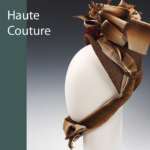 HAIR & HEADGEAR
HAIR & HEADGEAR
- Hair was pulled back at the sides & worn in a low knot or cluster of ringlets
- Later in the era, hair was swept up to the top of the head
- Women started to cut their hair, but only in front
- Fringe or bangs were fashionable throughout the period
- Bangs were curled or frizzled over the forehead & called “Josephine Curls” in reference to the 1800’s Classical Greek style
- Bonnets had curvy brims & resembled hats except they had ribbons tied under the chin
- The “Aesthetics” wore their hair long & frizzed
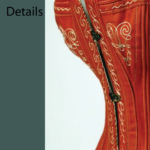 FABRICS, DETAILS, & ACCESSORIES
FABRICS, DETAILS, & ACCESSORIES
- Velvet was a very popular fabric in this period
- New light weight & soft wools were now being woven in mass production, & were favorites for winter or suitings
- Cooler cotton & linen were used for summer
- Colors were darker with bottle green, deep wine, navy blue & black coming to the fore
- Winter gowns were made in darker hues
- Summer gowns were of lighter colors
- Drapery fabric was thicker, harder, & considerably more rigid than in the 1870s
- Satin was popular. It was more crisp & rigid than we know now
- Evening gowns were worn with long over the elbow or shoulder length gloves of fine kidskin or suede
- Large hats, ornate jewelry, & parasols were worn with everything
- Boas were very very popular, & are usually what fashion historians use to depict the end of this era
- Boas were made of feathers, fur, or light fabrics. They were long “snakes” that wrapped around the neck multiple times
- The umbrella, while invented earlier, became THE item used by both men & women for everything from walking to self defense
- Choker necklaces & jeweled collars were fashionable under the influence of Alexandra, Princess of Wales who wore this fashion to hide a scar on her neck

—— ACTUAL GARMENTS OF ERA ——

(above) “Traveling Suit (no Bustle between Bustle Eras 1 & 2) 1881″
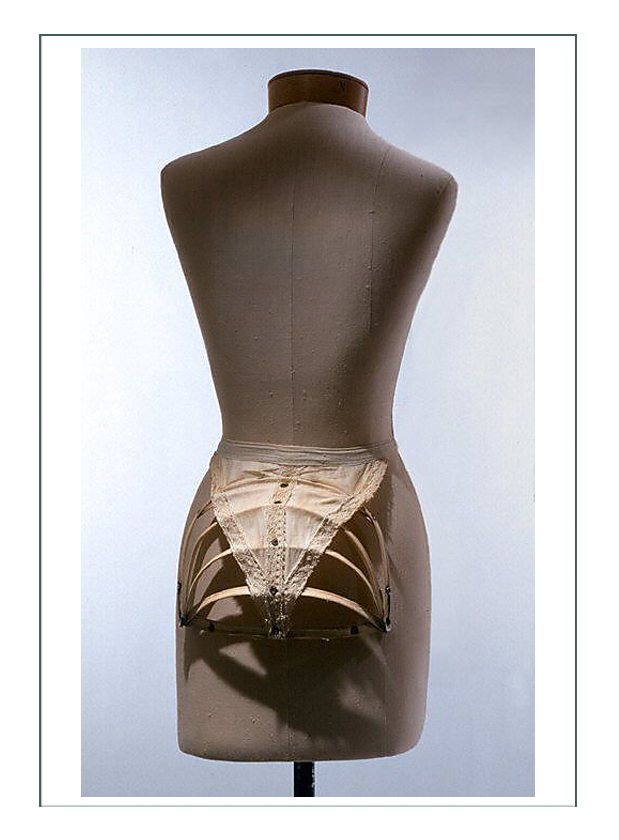
(above) “Small Bustle 1881”
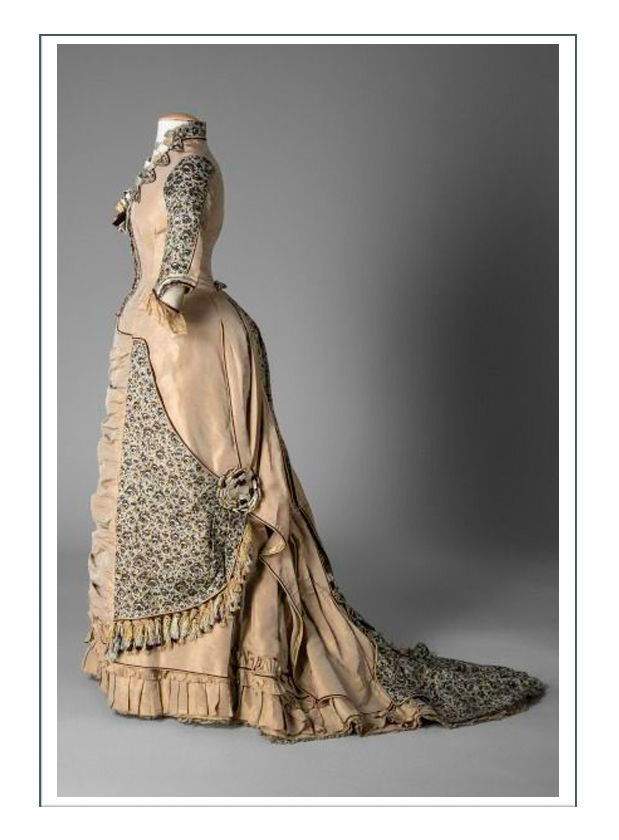
(above) “Tea Gown (Small Pad Bustle) 1882″
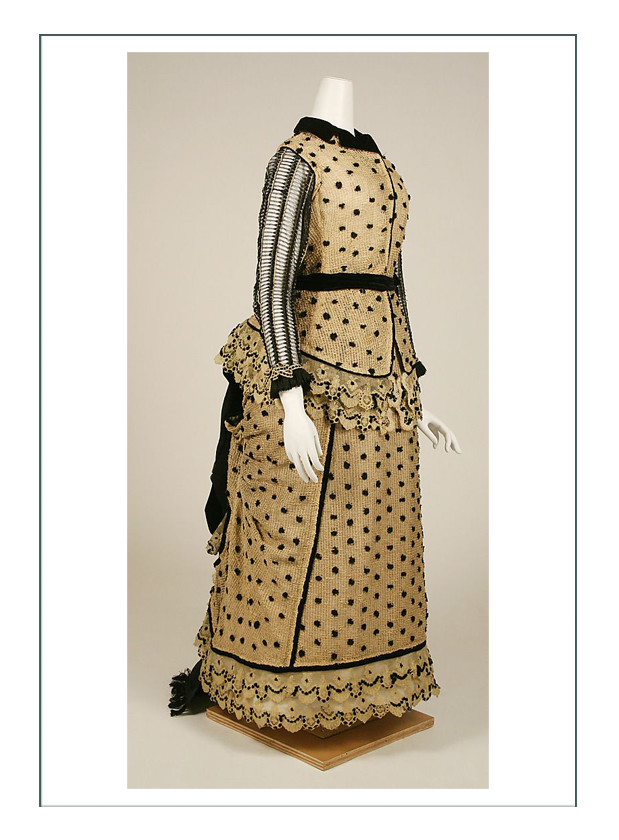
(above) “American Made (No Bustle) 1883″
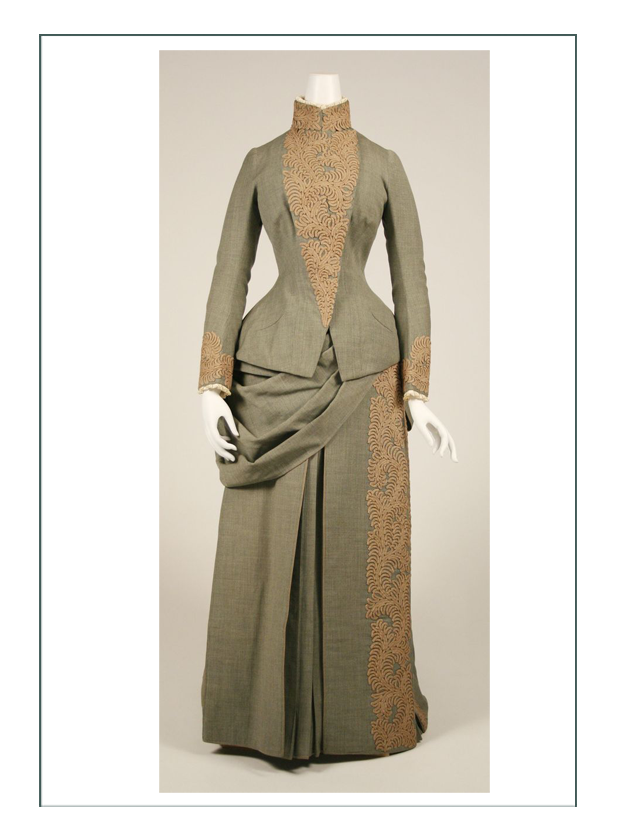
(above) “American Sidesaddle Riding Habit (no Bustle between Bustle Eras 1 & 2) 1883″
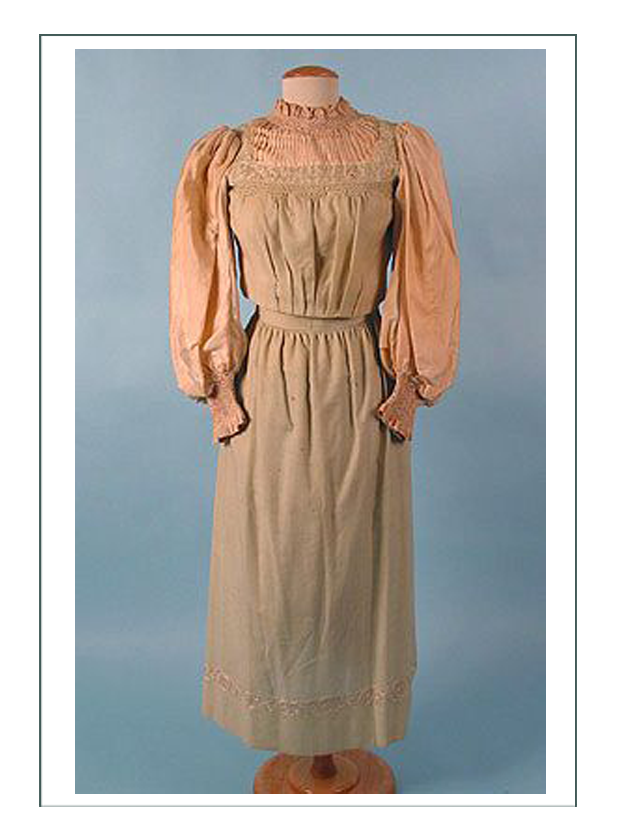
(above) “Reform Dress by Morris 1883 est”
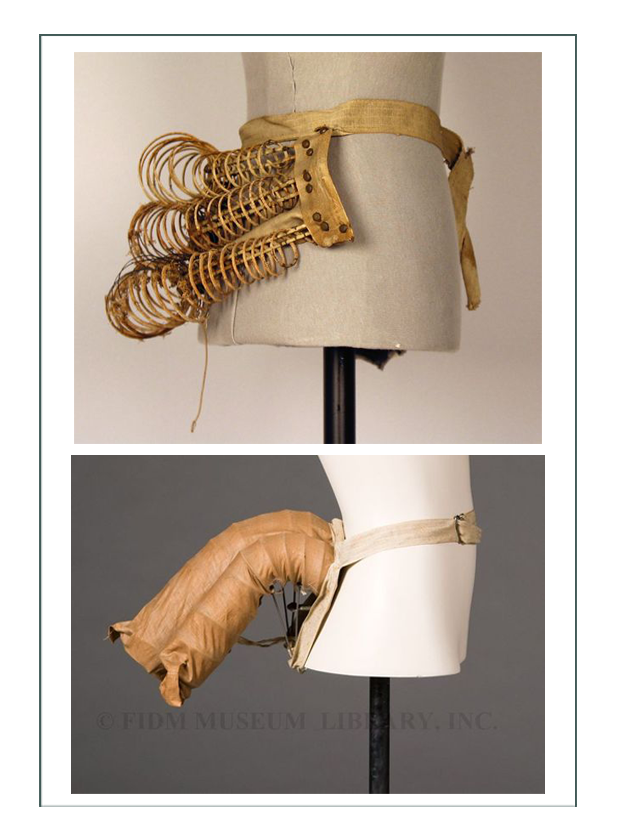 (above) “Wire Bustle 1884 (top) & 1885 (bottom)”
(above) “Wire Bustle 1884 (top) & 1885 (bottom)”
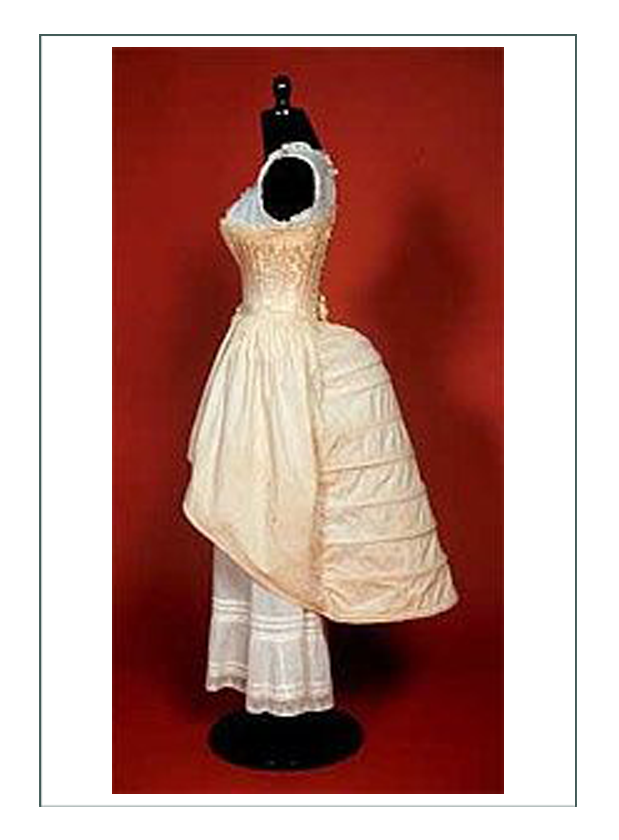 (above) “Large (2nd Era) Bustle Begins Again 1884″
(above) “Large (2nd Era) Bustle Begins Again 1884″
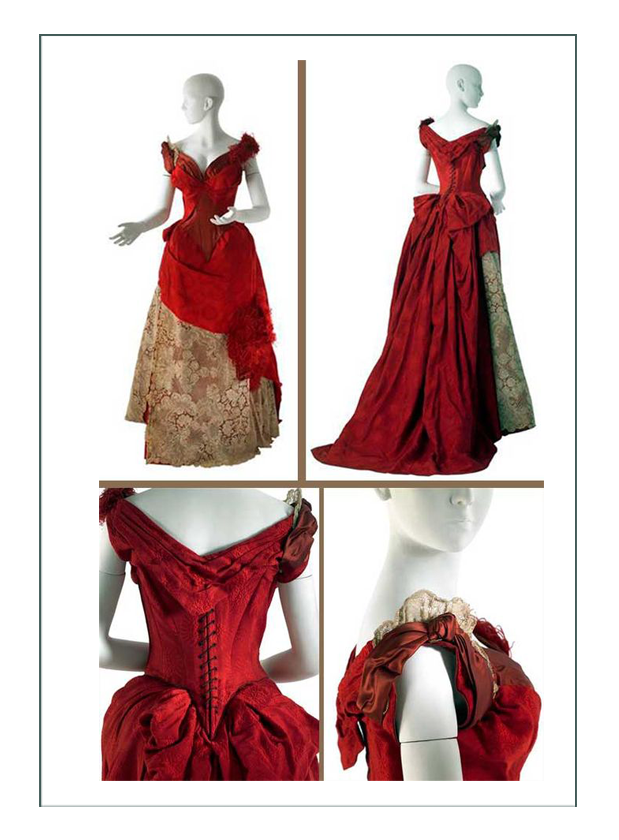
(above) “Court Gown (no Bustle; leaving Bustle 2 era) 1888″
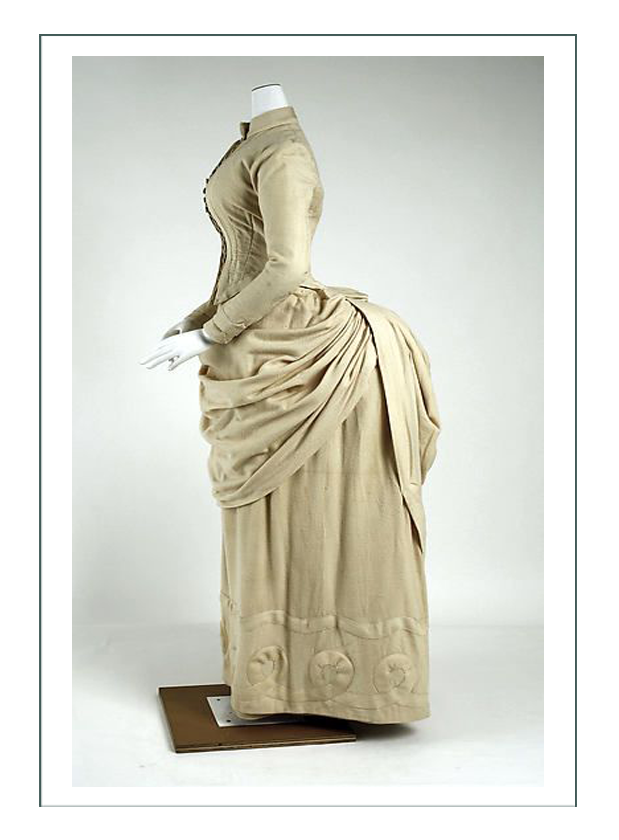 (above) “2nd Bustle Profile 1885”
(above) “2nd Bustle Profile 1885”
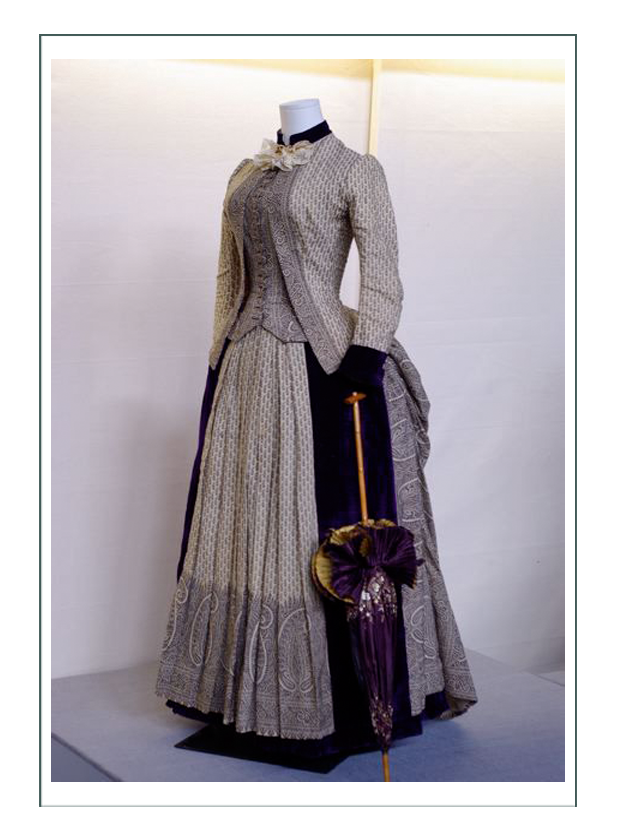 (above) “Paisley Wool Suit 1885”
(above) “Paisley Wool Suit 1885”
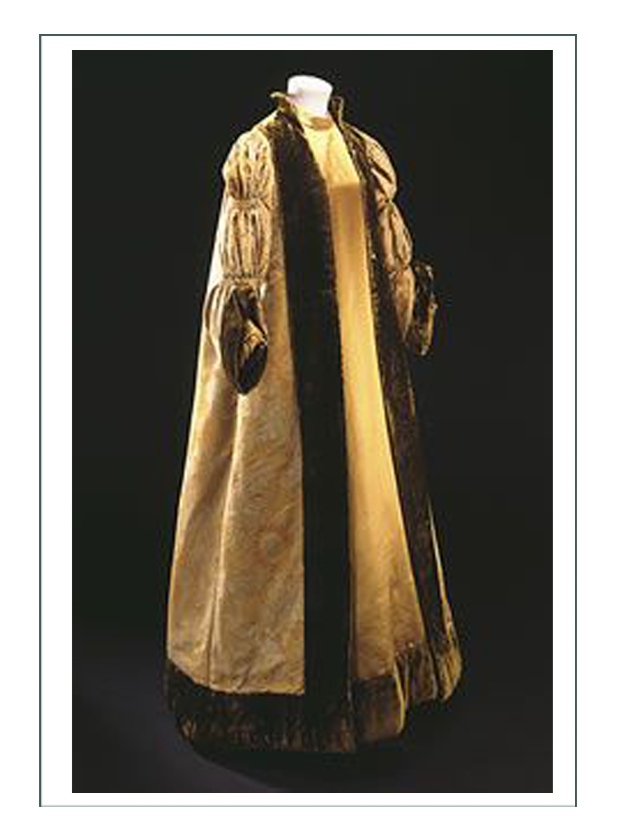 (above) “Liberty Aesthetic Gown 1886 est”
(above) “Liberty Aesthetic Gown 1886 est”
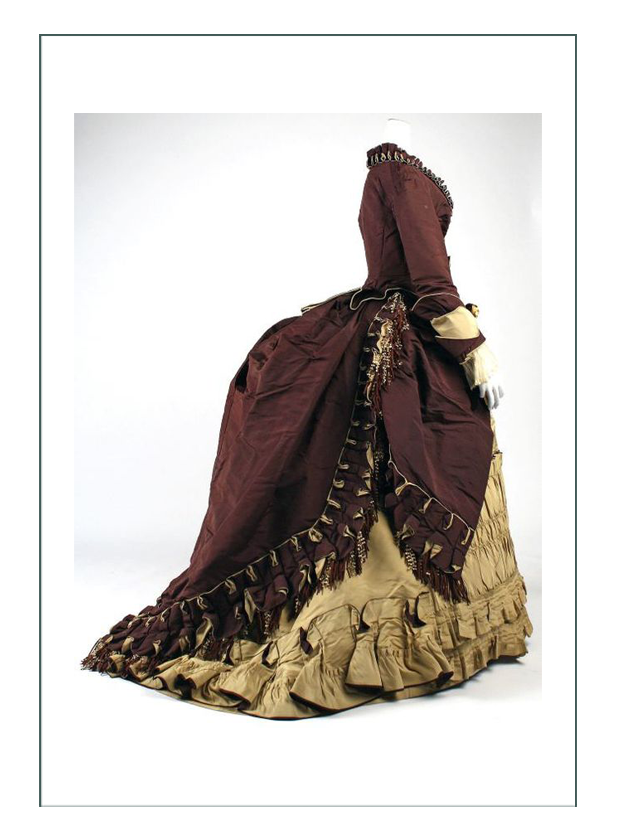
(above) “Travel Ensemble (Large 2nd Era Bustle) 1886″
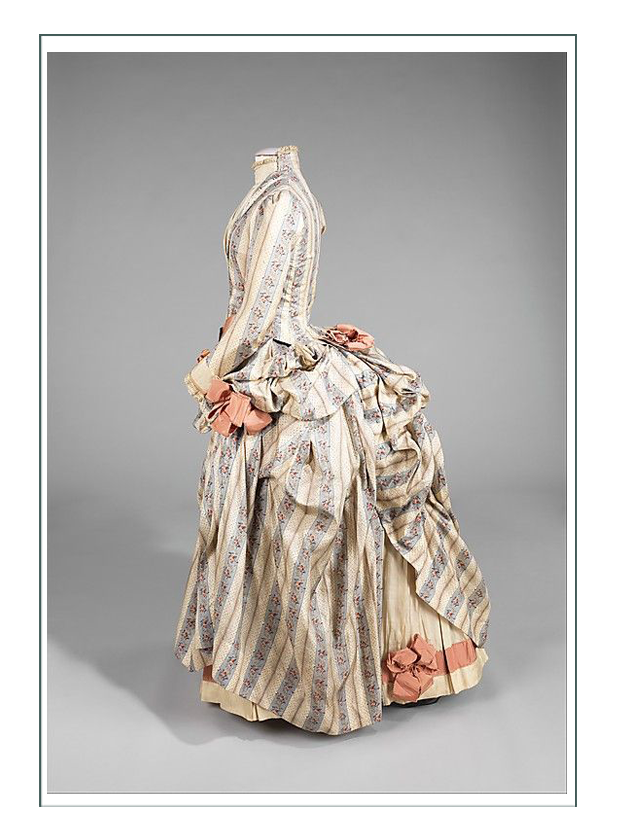 (above) “Afternoon Dress (2nd Era Large Bustle) 1886″
(above) “Afternoon Dress (2nd Era Large Bustle) 1886″
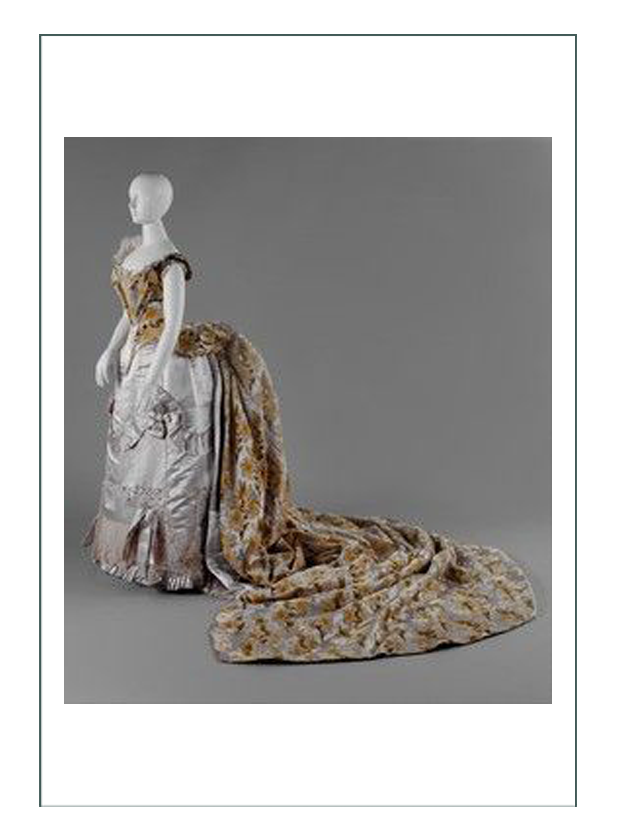 (above) “Last Bustle Before it Ends by Worth with Train “1887”
(above) “Last Bustle Before it Ends by Worth with Train “1887”
 1878, 1879, 1880, or 1881??
1878, 1879, 1880, or 1881??
This project was designed around the film “Tombstone”, which depicts the year 1881, yet Rebecca described her desires for her ensemble to be closer to the fashion of 1878-79 (Natural Form Era). Not absolutely resolved to be historically accurate for her wedding, Rebecca agreed to a mix of the design elements of 1878-1881 in order to provide the “look” she was over.
If we are going to pick and choose the fashion elements we want to use to build this ensemble, we need to know exactly WHAT are the differences between the middle ’70’s, late ’70’s, and early ’80’s. Following is an excerpt from our blog earlier this year discussing those very nuances:
1870’s vs 1880’s Fashion Evolution

French Designer Worth had introduced the.. .. draped overskirt. His underskirts or linings were in a contrasting color, which was revealed when the draping was pulled back over the rear end. This was considered the “soft bustle” fashion silhouette which lasted in various forms from 1867 to 1875.
As the 1870’s approached… It still had the shape of the large, ovoid crinoline hoop 1868-1870, but the draping was piling up in back, and the skirt was losing the round fullness in the front.
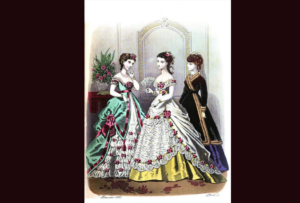
Waistlines began to rise.. ..ever so slightly, and became rounder.
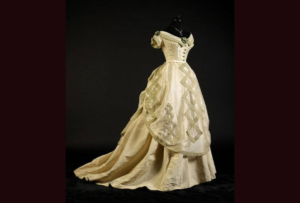
In 1868 there were more overskirts piled on… ..top of the draped fabric in the back over the rear end. They made the woman look like a piece of upholstery. Other top skirts were called aprons and they were also draped making the wearer look like a piece of elaborate upholstery.
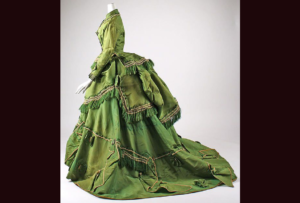
By 1870, ballgowns always had.. .. a train in back, dragging on the floor. By 1873, every day dresses would also have a train.

By 1875, every dress had a.. .. train, and the front of the skirt became less ornamented, flatter, and the crinoline was gone.
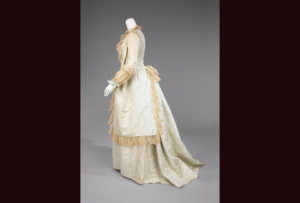
Silhouettes is pleased to have acquired.. .. this authentic 1875 ballgown in perfect condition. It has REAL whale baleen stays in the bodice with original construction methods to study – plus modifications made later when women would wear their old clothes to costume parties. It is currently for sale on our “buy” pages.

You can see the difference between 1868 and 1875 shapes below… … because the skirt and draping had lost the look of an oval shaped crinoline, in favor of a tiered draped and frilled train. The front became plainer, with the entire skirt silhouette much less symmetrical. The trains got more and more ornamented with frills, pleats, ruffles, braids, and fringing The 1875 bustle evolved out of a gradual transition from draping to a soft “polonaise” style reminiscent of the 18th century.
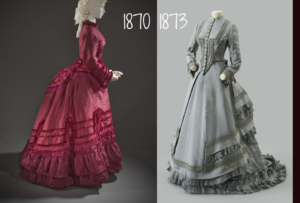
The home sewing machine was to blame.. .. for the copious amounts of detail and trimming. Trim was cheap and readymade and easily available to most women across America in the early 1870’s, as the design of the machine was improving constantly from the original Singer models of 1861.
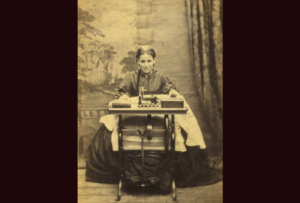
Change was also due to the new synthetic dyes featuring.. .. new intense hues of magenta, purples, blues, and greens. The early 1870’s with a sudden interest by the public in science led to many new inventions at the time.
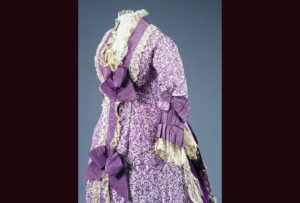
Draping on the back of the skirt got more elaborate.. .. as the decade of 1870 progressed, and then the ornament went to the front of the skirt.
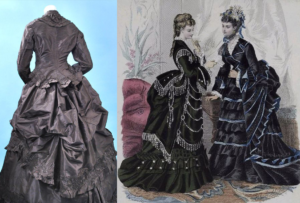
Where did the idea for draping the rear end come from? Parisian designers at the time, with wealthy and influential patrons like the Queen of England and Empress of France were certainly initiating the changing styles, but in reality, the world had seen quite a bit of this before. The various “rump” and “polonaise” styles of the 1780’s reappeared by the 1880’s, although the latter would add a train and more on the bottom. One can only guess that was because a decade later, fabric, trim, and clothing was much cheaper and easier to obtain – plus fabric was wider than the 22-26″ available in the 18th century, so the 19th century designers could put a lot more back there.
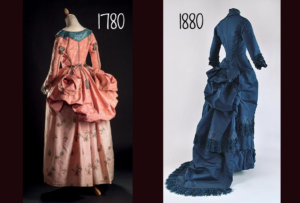
In the 1780’s fullness over the rear was made by.. .. a false “rump”, almost always some stadium cushion like pillow over the rear end. While the earlier 18th century “farthingale” (think bicycle rim around your waist) was metal and structured, it was not nearly the engineering accomplishment of the many types of early bustles in the first bustle era leading to 1880.
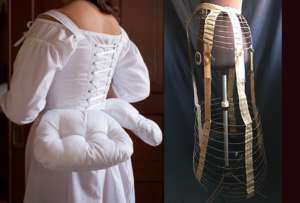
Invention of the bustle allowed more and heavier fabric.. .. to be hung over the rear than could a simple stuffed pad, thus allowing long trains and skirts that dragged. The early bustles were “crinolettes”, which still had pads over the rear end, but added metal loops covered with fabric. Early crinolettes were specifically designed to just hold the fabric away from the legs so a woman could walk.
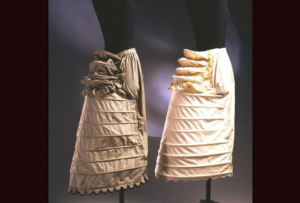
As draping and trim got heavier and more numerous.. … the “crinolette” evolved away from just keeping the drapes away from the back of the legs, into a shaping structure in themselves. Different designs accomplished different things; a crinolette, still considered a transition between the earlier crinoline and the bustle to come, was getting stronger and stiffer.
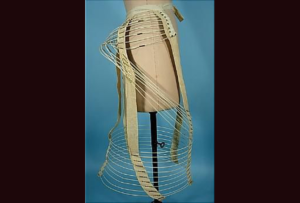
They were called “bustle cages”, as they got… .. heavier, stiffer, and began to form the shape of the dress. This was called the “first bustle era” which would come and go pretty quickly between the mid 1870’s until about 1879 when they would disappear in favor of lightweight “tournures” during the natural form era, and then reappear as the huge “horse rear end” 3rd bustle era.
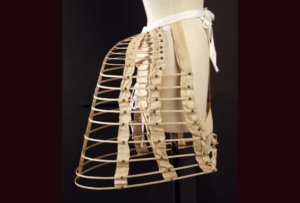
There were 3 bustle eras, with an “in between”… .. when light understructures and draping slimmed down the silhouette for about 3 years. The “natural form” era between the mid-1870’s 1st bustle era, and the 2nd one only looked good on long, tall, lean, and young women, so didn’t last very long, although this is the style most often depicted in movies and shows about the “Wild West”.
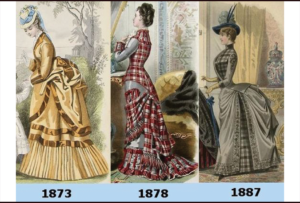
We’ve been discussing what defines Early & Mid Victorian.. .. fashion. So far we have discussed the corset (longer, cinching, different shape), the skirt (becoming assymetrical with fullness in the back and a smooth front), dyes (synthetic), methods (in home sewing machine), and designers (“Haute Couture” out of Paris creating “new” lines under directives of royalty like Eugenie of France influencing Victoria of England). We also discussed culture – differences in Europe and America with class distinction, and sources – where did fabrics, trims, ideas come from.
Now we’ll go straight to the silhouettes and elements that make them.
Silhouettes & Elements That Made Them
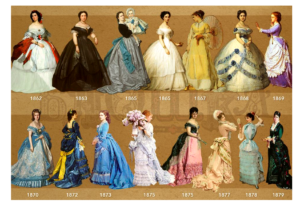
A Silhouette is the recognizable shape of fashion… .. as it changes. It is not exactly a black line drawing as we show here because it is in 3 dimensions (heighth, width, length) with subtle variables – but historians can place them through the most distinguishing characteristics. Regard yesterday’s post with drawings of women, and compare to today’s picture silhouettes.
You’ll note that just in 2 short decades, in the middle of the Victorian fashion era, the silhouette was very easy to distinguish and changed quite drastically. This period from the early 1870’s to the late 1880’s is probably the most confusing in American history because fashion went from the huge crinolines to the bustle to nothing at all to an even bigger bustle before it suddenly disappeared in a “puff of smoke”.
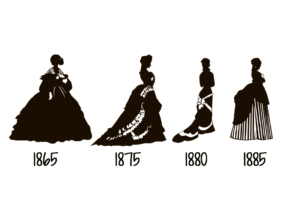
Along with the changing shape of skirts & draping… …The other main feature of the style change was the introduction of the cuirasse bodice which dipped front and back extending a little over the hips. By 1880 the soft bustle styles of the 1870s had totally disappeared.
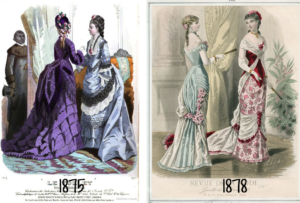
Between 1878 and 1880 the bodice… .. was becoming more form fitted, clung more to the hips, and seemed to integrate the skirts into the bodice, although they were still 3 parts: bodice, skirt, drape/tunic. This “armor like” bodice defined a brief 2-4 year period called “Natural Form”.
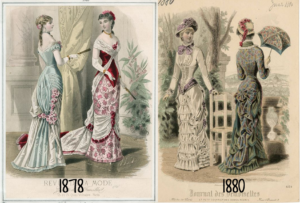
By 1885 the “unnatural” structures would be back… … and the “Natural Form” era which only looked good on long, slim, and young women, would be over. The 2nd “large bustle” era would last only a decade or so. As with any fashion era, there is no distinct line between one or the other, because just like today’s women, some would hang on to the older fashions, while others would embrace the new. The date of a fashion Silhouette was given by historians when the key characteristics were predominant in fashion periodicals (such as these we are showing) announcing the new style for women to adopt, or when it was implemented by key fashion figures such as queens and empresses; thus the naming of “Victorian Era”, etc.
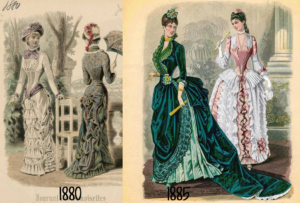
Interestingly there was no “Eugenian” fashion era… .. even though Queen Victoria of England, for whom the fashion eras from the start of her reign in 1837 until her death in 1902 was the namesake, was good friends with Eugenie of France (Empress, then wife of the President through France’s changing political structure). Eugenie and her key Parisian designer – Charles Worth (and others) were responsible for creating the concepts, although Victoria is credited with the marketing and spread of fashion, especially to American women. (see earlier blogs about Eugenie and Worth).
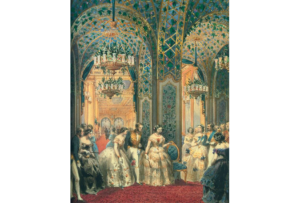
The 1878 Cuirasse Bodice… .. as the new, long “armor-like” bodice was called, gave a clear and visual difference between the early and mid Victorian Eras, and what was evolving to become Late Victorian.
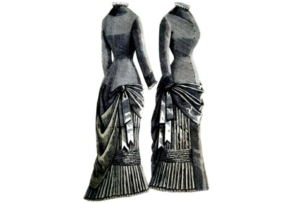
The natural form “cuirasse” style… .. was very expensive as it demanded a high level of skills by the dressmaker to get the body-tight fit, was made of fine fabrics and trims, and was structured much like the corsets of the era including boning and special seaming and reinforcements to hold up to rigors of daily wear.
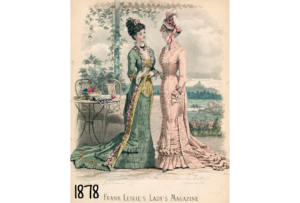
Enter a new fashion icon for American women… … Princess Alexandra of Russia who looked beautiful in the long, slim line of the “Natural Form” era with its fitted bodice, expensive draping, and beautiful fabrics. At the peak of her political power, Alexandra gave the name of this shape/Silhouette the “Princess Line”.
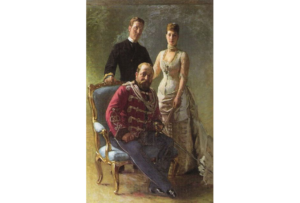
Alexandra’s “Princess Line”.. .. had a “sheath” or “cuirasse” bodice line that was even longer than the early ones. It now had no waist seam and the bodice and skirt were cut in one – unlike any other garment previous which was always at least two pieces – bodice and skirt.
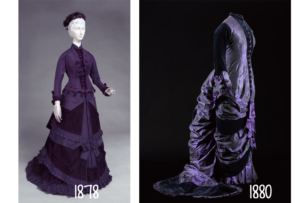
With just a 2 year difference, the fashion silhouette changed… … drastically with the Princess Line, where the dress and bodice were cut as one. This demanded very wide and durable fabrics to sustain both the elaborate draping of the skirt, and the heavy built in structures like a corset into the bodice. They also had to be draped on the body to get the exact fit, making this a hard to reach fashion ideal, worn best by royalty and those with the means to pay for it.
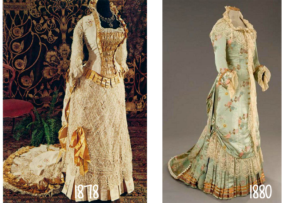
By 1878 the cuirasse bodice had reached… … the thighs. It was like a very long corset and went even lower in center front and center back, extending well down the hips creating the look of a body encased in armor.
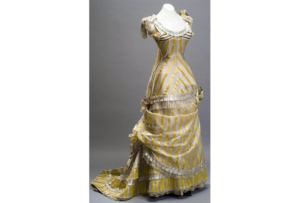
The ideas merged in 1880.. .. so that the idea of the Princess line (bodice cut in one long piece with single vertical panels from shoulder to hem) and the Cuirasse Bodice (armor tight skin fitted bodice almost to the knees and over the rear) made a very slim and elongated silhouette.
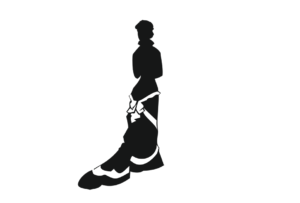
The long, slim line was emphasized by… .. long trains on the back of the skirt – even for day wear. These were sometimes integrated into the draping of the skirt, and sometimes detachable. The petticoats underneath we designed to enhance the silhouette.
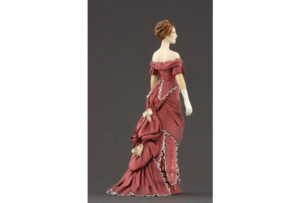
A tournure or bustle pad was the right thing… .. to wear with the new form, as the small bustle which had been used for a few years prior, were not needed with the cuirasse or Princess sheath dresses, but a small pad or “tournure” helped lift the trims, draping, bows, and frills in the back over the rear end so that they would drape more elegantly.
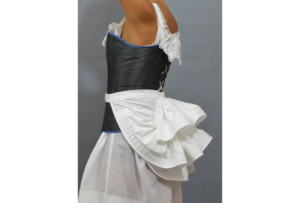
There were many types of ruffled… … petticoats with and without trains. Each had a specific way of lifting the skirt. Some were stiffer to lift up heavy fabrics like wool or linen, while most were fairly light in weight using just layers of ruffles or thin twisting strips of horsehair in cotton (a “tournure” in French) to give a light support. Most just used a rump pad much like had been used in the 18th century to make rear ends look bigger.
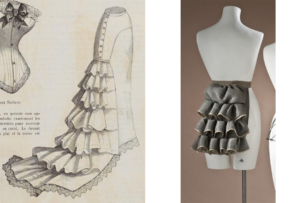
Note the position of the fullness changed… … lower to almost the knees when the cuirasse bodice and Princess sheath took over the fashion ideal. The lifting tournures and bustles of the mid 1870’s suddenly shifted to a lower position around 1880 so the fullness was not specifically over the rear end (although decoration and draping gave fullness there) for the undergarments. This is the noteworthy feature which designates a short 3 year and short lived period called “Natural Form”.
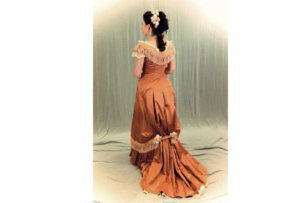
It is easy to get confused, as there was a bustle era.. … then no bustle (“Natural Form”) and then bustles again. During all the times, ALL fashion aimed for the same silhouettes. That makes it hard for us today to determine which is which, since a tailored walking dress or riding suit of 1879 would have the same features, design, and construction, but might look completely different than a ball gown.
Whenever defining a date of an ensemble. Look for the construction. In this we look for the structured long bodice through the waist and down to the knees with a single vertical paneled seaming – regardless of whether it is split as with a riding jacket, or full as with a ball gown.
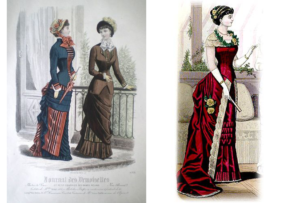
The 1880 silhouette, made by the… .. new Princess line and the Cuirasse bodice combined, was a sleek and slim look and required professional dressmaking skills to get a flattering fit. When done well and fit correctly it was gorgeous, but most women just had swaths of fabric wrapped and arranged across the garment to hide dressmaking flaws.

The slim lines of 1879-80 were only really good… … for very slim women and those who did not have to work. It took time to get into, was difficult to move in, and required yards and yards of expensive fabrics and trims to get the look right. It was a look for young and tall women, and lasted barely 3 years because of the cost, difficult to wear, and complete lack of function.
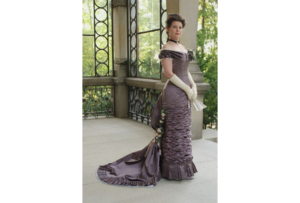
For some reason, Western movies like Natural Form fashion.. .. and the late 1870’s to early 1880’s time frame for their depictions. It is likely because those were the days when Wyatt Earp and brothers were at the peak of fame, or because it was the time of cattlemen range wars. Caroline Lockhart, famous Western novelist from Cody, Wyoming, wrote her stories about real people in her real time (1910’s) in reaction to all the favorite writers of the day like Zane Grey telling the same tales of 1880 with the good guy in the white hat and the bad guy in the black.
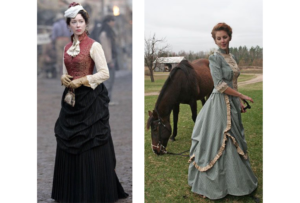
Some of the newest Westerns just out.. .. like “The Lone Ranger”, have taken their 1880 depictions to extreme. In a world of fantasy costuming, though, saloon girls can dress like ladies, and ladies can paint themselves like saloon girls. They don’t have to be historically correct.
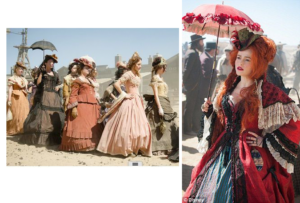
And some of the older Western movies like… … the Wild Wild West of 1999 which take place in the Natural Form Era (around 1880), were quite a bit off the mark. Like many of the Westerns of the 1940’s, it appears instead of a corset or a heavily boned cuirasse bodice, she is wearing a spandex body girdle under her allegedly historically accurate ensemble.
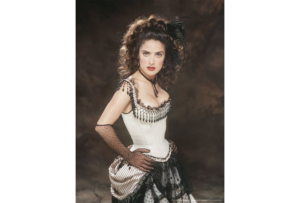
Interestingly, as this was written long before this project, one of our favorite Western movies for historical accuracy though. … is the 1993 “Tombstone” with Kurt Russel. Not only are the character depictions spot on (wives are sedate in homemade goods, while the rich actress is in high fashion silks with copious trims), but they even have the undergarments fitted as the characters would. The “regular women” wear “every day clothes” with some fitted better than others, while the “high fashion women” are flawless in design and accurate detail.

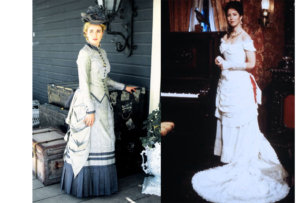
In the movie “Tombstone”, the dead on accuracy… … of the men in shooting and the women’s ensembles is legendary. In one of the opening scenes, you can see the leading ladies wearing the long, single seamed Princess dress of 1878-79 before it merged with the Cuirasse bodice that made it armour like (which the high fashion characters wore).
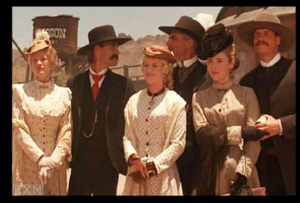
It’s still fun to watch old Westerns like Gunsmoke.. .. where, in spite of her corsetless shape and historical inaccuracies, you’ve still gotta love a woman like Kitty who runs her own business wearing form fitting Natural Era made out of rayon and spandex.
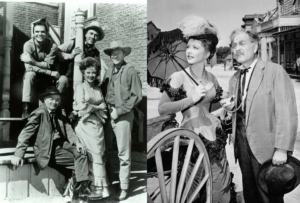
And we must give credit to outstanding Natural Era designers… .. from other genres of film and TV, like this gorgeous ensemble by designer Joan Bergin, worn by Scarlett Johannson in “The Prestige”.
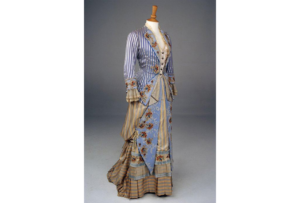
Also honoring the outstanding design work of… …Gabriella Pescucci for “The Age of Innocence” gowns for Wynona Ryder. One can clearly define each year as the show progresses from 1878 into the 1880’s. The skirts and draping are the keys to date identification.
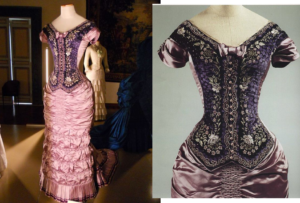
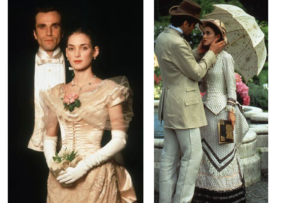

And one last nod to the “Penny Dreadful”… …Showtime series with Mrs. Eva on set.
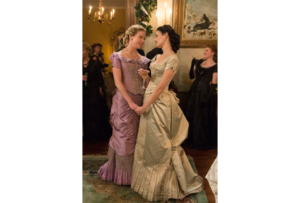
Back to work now.. we have been discussing Natural Form.. .. and how the Mid-Victorian Fashion changed drastically between the early 1870’s and the early 1880’s, covering the 1st bustle era with its various shapes and drapes and structures, then no bustle (Natural Form), and now as the bustle reappears larger than ever.
To figure out the date on a historical garment, the best clues are:
- location and type of draping
- seam construction of the bodice
- shape, especially symmetry or assymetry of the skirt
- the corset (what does it DO?)
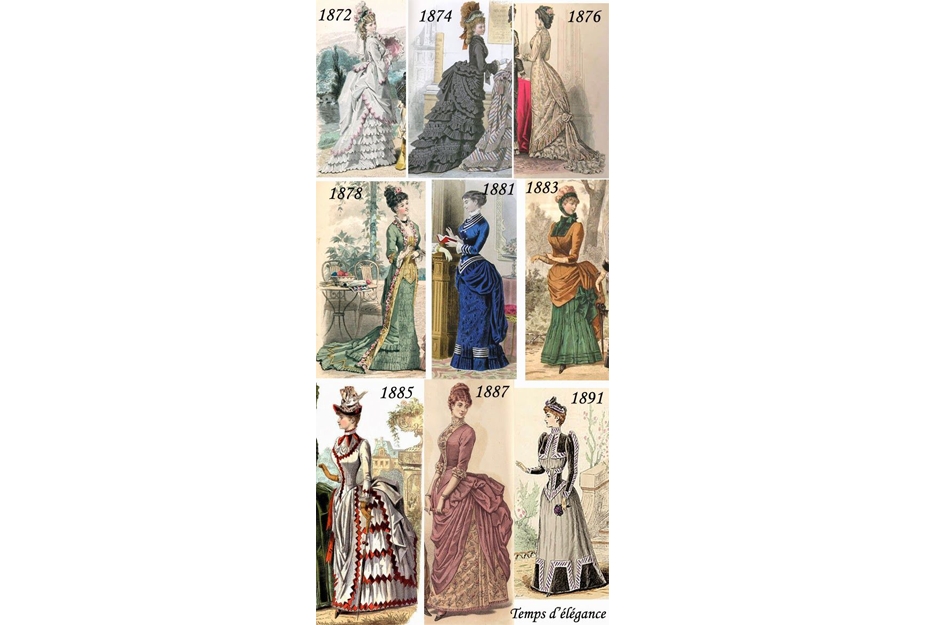
Quick Review of Victorian fashion… The Victorian Era started officially in 1837 when Queen Victoria of England was crowned and took over as leader of world fashion, knocking the French off that pedestal. That Early Era that took the Regency Fashion concepts of 1800-1828 and made the skirts bigger, the corsets tighter, and the bodice lower and longer, evolved through the 1840’s an 1850’s. Suddenly in the 1850’s the hoop or crinoline was designed by Parisian designers, and carried to Victoria by her buddy Eugenie – thus the French took over the fashion lead again.
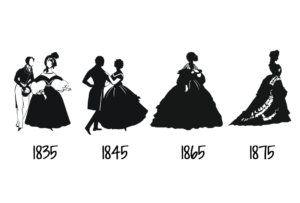
And Mid-Victorian quick review.. By the early 1860’s, under the innovations of Charles Worth, Eugenie’s designer and a whole variety of cultural and economic factors including Victoria’s desire to help her lower classes by manufacturing everythin in England, and Eugenie’s desire to have everything made in France – the crinoline hoop became huge. 1862-1865, the peak of America’s Civil War was also the peak of the huge skirt.
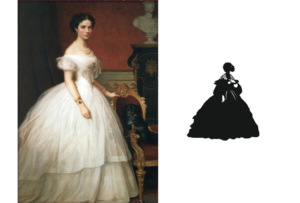
Late Mid-Victorian (Gilded Age, Reconstruction) review.. After the Civil War, Americans were obsessed with science and technology – bringing the sewing machine to common use and new synthetic dyes along with exponentially increased improvements in the textile and garment production industries. World wide trade and the full access to the Asias had the Middle Victorian Era full of new ideas that could be gotten for cheap.
The crinoline evolved into the first bustle era, the smaller ones like tournures and wire and tape bustles or padded rumps from about 1873-1877 (during America’s reconstruction where there was a “high low” class disparity in the “Gilded Age”) when suddenly all understructures disappeared during the “Natural Form Era” for about 3 years.
Garment construction changed to the long lines and lean fronts of the Princess and Cuirasse silhouettes. Much of that was due to easier and cheaper access to fabrics and trims, plus the home sewing machine.
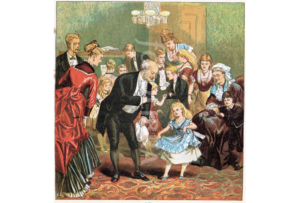
That takes us to 1883 America, where we find women.. .. working at their home sewing machines, buying undergarments and materials from catalogs, and copying the styles of the Queen of England at the beginning of the “3rd Bustle” or “Hard Bustle”, or “Horse Rear End” bustle era which signaled the start of the Late Victorian Era.
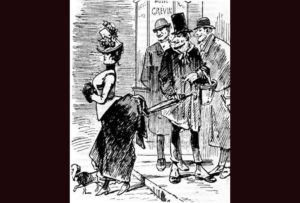
The new Bustle Era of 1883… … All of a sudden, seemingly out of nowhere, in 1883, every woman had to wear a huge, shelf like structure jutting out of her rear end like the back of a horse. The style had been shown by fashion houses of Paris in 1880 in response to women not liking the Natural Form with it’s long slender and lean (expensive) form. This new type of bustle was much different that the two earlier bustle (and “non bustle” Natural Form) eras of the 1870’s. It depended on built structure underneath, which meant the layers and layers of draping and fabric used before, could be dispensed with.
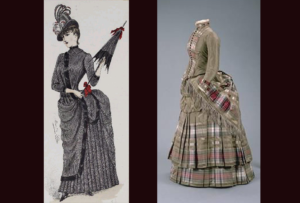
The new gigantic bustle of 1883… .. was worn with a dress that had much less drapery and fabric than the many decades before. While the structure was huge, the dress itself was slimmer, more fitted to the body, and the bodices was much more severely tailored to fit than those of 1879-1882.
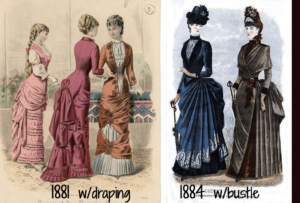
The new bustle dress of the early 1880’s… .. with its very fitted bodice had a Princess line meaning it was cut in long panels from top to bottom. The front overall was much flatter because of the panels. What drapery there was, went to the front and hung like a tidy apron.
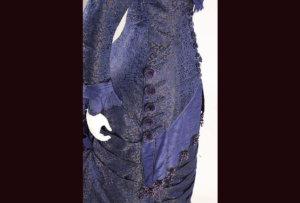
The little front Apron drape of 1883… .. would disappear as the 1880’s progressed.

How to tell the difference between the 1870 & 1883 bustles
It is difficult, especially since there was crossover. The crossover happened largely because the new style was being introduced while most women were still wearing the old styles everywhere else. The style was definitely and intentionally being initiated by fashion designers in France.
1) Check the shape of the structure. The early ones were worn mostly 1870 – 1875. The 2nd 1883-1890 (although most had disappeared by 1886), but the 2nd ones had been introduced in Paris in 1880.
2) Check the hairstyle.
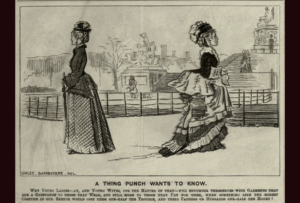
The hairstyle will tell you whether it’s an early or late bustle… .. Hair in the 1870’s was soft, with ringlets and braids. It had a vertical orientation and was piled vertically high to hold the bonnet which was precariously tipped forward. It was left to fall artistically and arranged to be romantic and alluring. This was one of the biggest eras for wearing false hair; extensions, pads, wigs, and braids and plaits.
Hair of the 1880’s was tamped down, coiled, and neatly piled on top of the head. If it was curled, the curls were tight and tightly to the head. There was some “frizz” along the face to soften the severity, but it was not nearly so “romantic”.
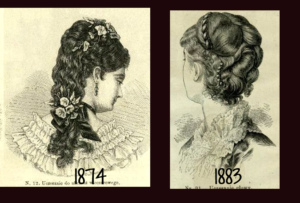
The 1870’s “1st Bustle” started from… … French designers intentionally to create something as different from the crinoline as they could get, and to take advantage of the cheap and abundant fabrics and trims. By draping techniques, designers pull the large amounts of fabric previously used in the huge round skirt and pulled it to the back. The crinoline had already begun to elongate towards the back, so it was a logical next step.
The surplus fabric was draped and the shape was made by tapes and buttons sewn into the skirt. To support the weight of the large amount of fabric, the small crinoline of the prior fashion era was brought back, and instead of horsehair and tape, it was made from a steel frame that hung around the waist. In some situations the “tournure” which was twisting layers of horsehair was used in flounces to support the weight of the back of the skirt.
By the mid 1870’s the crinoline was discarded altogether in favor of this “1st bustle”.
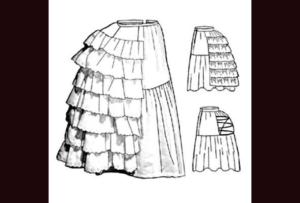
The 1870’s bustle can be distinguished from the 1883 by… .. looking at the fullness in the front of the dress. With the 1870’s style of bustle (or “tournure”), the drapery hanging over the bustle went almost completely down the front, or had the apron effect of draping. As it evolved the front drape became more a part of the skirt while the weight – visual and actual – started to pull to the back.
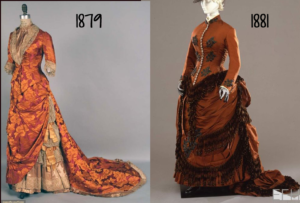
The slim Natural Form dresses of 1875-1883… … actually did have structural support in the form of “trained ruffled petticoats” to help carry the weight of so much draping. For women who were not slim and tall in these years, the “Tea Gown” became a popular alternate choice. It was a flowing type of robe that was not fitted at all.
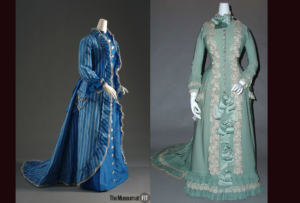
The 1883 bustle was first made of.. … a straw filled cushion sewn into the skirt, with a series of steel half hoops inserted into the skirt lining all the way to the ground. This threw the skirt way out horizontally from the waist.
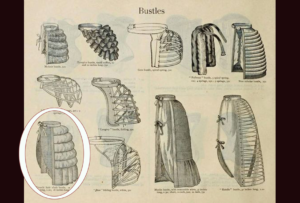

With the 1883 bustle, drapery moved to the… ..sides, or to the front panel of the skirt for daily wear. Ballgowns were more draped and similar to the prior era. To recognize this later bustle, look for a smoother and more shelf like shape over the rear end being worn with a very tailored and quite structured square shouldered bodice.
Also check that the hair is tighter and less free around the head with no ringlets and braids pinned up. The hair of the large bustle era looks quite a bit like that of the 1890’s-1900.
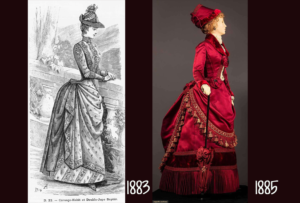
The other real difference between 1870 & 1883 bustles.. .. is that in 1883-90, the dress was made of plush fabrics like velveteen, plushette, and sateen. There was a depression in 1880-90 in Europe, so even women of wealth used cheap, mass produced fabrics and trims. Regardless of the fabric or trim, the idea for all classes and status was to have an armorlike bodice with severe tailoring.
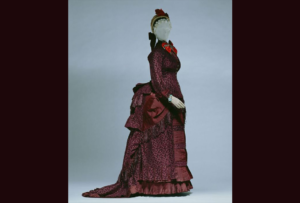
Victorian high fashion designer Charles Worth.. .. in Paris (discussed in detail earlier this summer during the “mid-Victorian” era section) was leading the bustle styles and the use of fabric and trims. Designing for key fashion influencers such as French, English, and Russian royalty throughout the mid to late Victorian era, the Worth House of Fashion in Paris set the trend for all to follow.
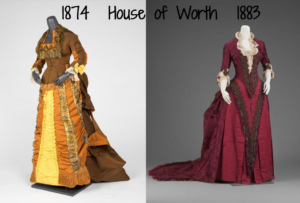
The late Victorian bodice.. .. in the hands of designers like Charles Worth of Paris, almost seemed to “mature” through the 1880’s and 1890’s as it became more tailored and more custom fitted and molded to each woman’s body. Worth’s early ensembles almost seem “clumsy” compared to the later ones.
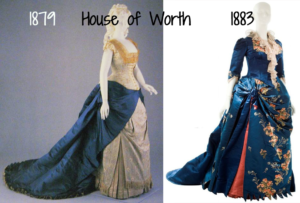
Remember in 1883, the large bustle designs were.. ..completely new inventions! Designer Worth with the other Parisian fashion houses at the time were INVENTING the style from nothing. Worth was taking what had been and pinching and pulling and draping to try to come up with something new. While we see bustles as logical (though somewhat odd) parts of fashion history, one must remember that like Worth’s crinolines, the bustles were completely new inventions.
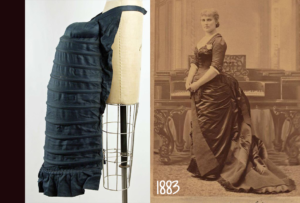
Granted, the 1880’s bustles were really evolved from… …18th century “rumps” and false bums”, but the application of new technologies in metal working, overuse of baleen and horsehair and so the new introduction of synthetics for padding and structures, made them very different than those of the prior century, although the overall result might have been very similar.
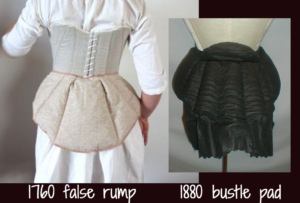
One might think all women of history were tiny… .. when one looks at garments hanging on mannequins in museums. While statistically women WERE much smaller on the average in the late Victorian era; e.g. median waist was 25″ vs today’s 32″, there were in reality women of ALL sizes from very small to very large.
The Natural Form era of 1878-1881 was a particularly bad time for large women.
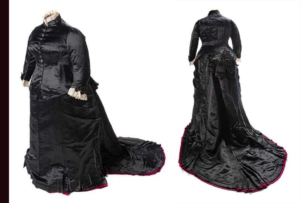
The 1880’s were much kinder to large women.. .. because everyone was trying to look large. The change in fashion matched a change in culture and economics. As the power of women to manage businesses, own property, to have rights over their children, and in many states like Wyoming – to vote! so did fashion ideals change to reflect women’s new status.
The ideal woman of 1883 was literally, as well as figuratively – large.
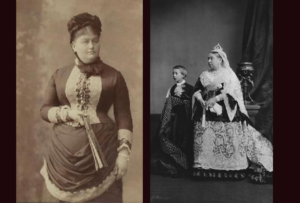
By 1893 & 12 years after it started, the 3rd “Late” bustle would disappear… .. to become just a pad over the rear end. This added on pad would be replaced by padding integrated within the new Edwardian “S Monobosum” corset of the new fashion era that was evolving at the end of Victoria’s reign.
Some sort of padding would be worn over the rear until 1909 when the long line corset and bust supporters would be invented by the same French fashion houses which heralded the end of Victorian AND Edwardian fashion eras at the advent of World War I.
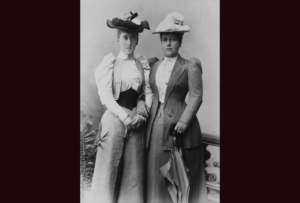
Quick thought before we dive into Late Victorian fashion… … One thing that stands out when ones like us spend most of the time studying women of history, and trying to figure out what they were thinking or knowing and so wearing, is that we modern people assume that things have improved and continue to improve in a straight line of sorts towards the future, with no looking back. Many modern people, except to enjoy theatre or movies, have no desire to know what came before, let alone wear it!
Once you learn, however, the secret of the adjustable corset with padding, or the 18th century bodice that still fits whether you gain a pound or lose a pound; once you’ve worn those lovely draping petticoats and skirts that hide flaws in thigh or derriere, or learned how convenient a nice pair of cotton split drawers are for using the restroom, it’s hard to shimmy into the rubberized skin tight synthetic clothing of today.
Of course, one can wonder “what in the world were they thinking??” when considering crinolines, bustles, and the gigantic sleeves we’ll be discussing next.
Modern or historical though, it still comes down to: what were/are they doing, what did/do they know about, and what did/do they have access to? While the 1860 swim costume will not win the next Olympics (and might drown somebody), a woman on the Oregon Trail would freeze to death in today’s spandex yoga pants and teeny lightweight short coats.
What women wore – and wear – is a reflection of society, culture, economics, and women’s roles at the time and place. This makes us those of us old enough to remember – what was with those fishnet stockings and mini skirts in the 1970’s??
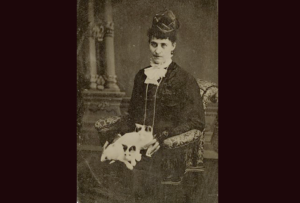
Please also take time to read the blog starting 9/4/19 on Lillie Langtry and her contributions to society and fashion in Europe and America from the late 1870’s to the 1910’s.
Click here to go to Rebecca’s Design Development Page, where we put this together (next)
Click here to go to the Main Page with the Finished Project
